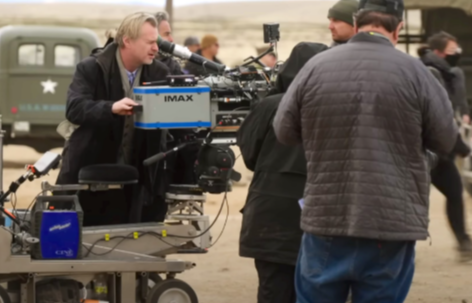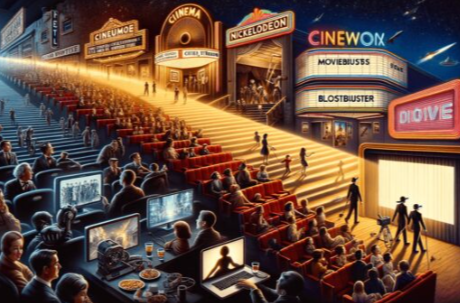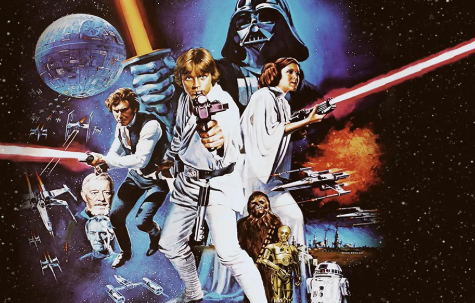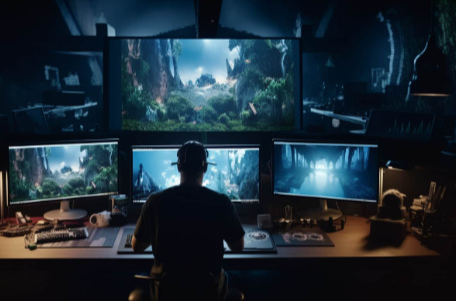Behind the Scenes: How Movies Are Made From Script to Screen

The filmmaking process is a meticulous journey that transforms concepts into captivating narratives. It begins with the idea and evolves through scriptwriting, where stories take shape. Each phase, from pre-production planning to casting, requires collaboration among diverse talents. The production stage breathes life into the script, while post-production refines the film into a polished product. This intricate dance behind the scenes reveals the artistry and effort involved, inviting exploration into the nuances of cinematic creation.
The Concept: From Idea to Script
In the intricate journey of filmmaking, the concept serves as the foundation upon which all stories are built; thus, transforming a simple idea into a fully developed script requires a collaborative effort among writers, producers, and directors.
This initial phase, known as concept development, is crucial, as it lays the groundwork for a film’s unique vision. During this period, the team engages in thematic exploration, probing deep into the underlying messages and emotional resonance of the narrative.
Discussions flourish, and ideas evolve, fostering an environment where creativity can thrive. Each participant contributes their perspective, enriching the concept and refining it into a cohesive framework.
Ultimately, this collaborative spirit empowers filmmakers to breathe life into their vision, paving the way for the cinematic journey ahead.
Read more: The Impact of Technology on Modern Filmmaking and Visual Effects
Scriptwriting: Crafting the Story
With a well-defined concept in hand, the next phase unfolds: scriptwriting, where the narrative begins to take shape on the page.
This collaborative process involves writers weaving intricate story arcs that captivate audiences and evoke emotional responses. Each character’s journey is meticulously crafted, ensuring rich character development that resonates with viewers.
Writers often engage in brainstorming sessions, refining dialogue and plot points to maintain momentum and coherence. The script becomes a blueprint, balancing creativity and structure, inviting directors and actors to interpret the vision.
In this phase, the freedom of imagination drives the narrative forward, laying a solid foundation for the cinematic journey ahead. Ultimately, scriptwriting transforms ideas into compelling stories that inspire and entertain.
Pre-Production: Planning Every Detail
As the script transitions from page to screen, pre-production emerges as a vital phase where meticulous planning lays the groundwork for a successful film. This stage encompasses budget management, ensuring resources are allocated wisely.
Location scouting identifies the perfect settings that align with the vision, while scheduling logistics keep the project on track. Team collaboration fosters creativity, allowing ideas to flourish, as a script breakdown guides production design and visual storytelling.
Risk assessment identifies potential hurdles, ensuring preparedness. Equipment rentals are coordinated to fit the production needs, and legal considerations are handled to safeguard the project.
A robust marketing strategy is also crafted, setting the stage for audience engagement. Together, these elements form a cohesive foundation for the film’s journey.
Casting: Finding the Right Talent
Casting is a pivotal phase in filmmaking, where the right talent is essential for bringing characters to life.
The audition process serves as the foundation for selecting actors, while chemistry readings reveal the dynamic interactions among them.
Additionally, embracing diverse talent enriches the narrative and reflects a broader spectrum of experiences, fostering a collaborative environment that enhances the film’s authenticity.
Audition Process Essentials
How does one identify the perfect talent for a film? The audition process is a collaborative journey involving casting directors and actors, where audition strategies play a crucial role.
Actors are encouraged to engage in thorough character research and select monologues that resonate with their interpretation of the role. Preparation is key, as it alleviates performance anxiety and enhances confidence.
During auditions, casting directors provide constructive audition feedback, guiding actors through the callback process. Adhering to audition etiquette ensures professionalism and respect in this creative space.
Ultimately, the synergy of actor preparation and insightful direction fosters an environment where the right talent emerges, ready to bring characters to life on screen.
Chemistry Readings Importance
While selecting the right actors for a film, chemistry readings serve as a pivotal tool in assessing the dynamic between potential co-stars.
These sessions mimic laboratory techniques, where the interplay of talent creates chemical reactions that can ignite memorable performances. Directors and casting agents observe how actors interact, akin to scientists observing reactions under controlled conditions.
By adhering to the safety protocols of the artistic process, they ensure a collaborative environment where performers can explore their chemistry freely.
The practical applications of these readings extend beyond mere compatibility; they can reveal the depth of character connections crucial for storytelling.
Ultimately, chemistry readings empower filmmakers to curate a cast that resonates with authenticity and emotional depth, enhancing the film’s overall impact.
Diverse Talent Considerations
As filmmakers embark on the journey of assembling a cast, the importance of diverse talent considerations emerges as a critical factor in shaping authentic narratives.
Inclusive casting not only enriches storytelling but also resonates deeply with audiences seeking representation and connection. By prioritizing diverse talent, filmmakers can create multifaceted characters that reflect the richness of human experience, allowing for more relatable and impactful stories.
Collaborative efforts among casting directors, producers, and talent agencies are essential to ensure a wide array of voices is heard and included. Embracing diverse narratives paves the way for innovative storytelling that challenges stereotypes and fosters understanding.
Ultimately, the commitment to diversity in casting is a visionary step toward a more equitable and vibrant film industry.
Production: Bringing the Script to Life
In the production phase, the vision of the script begins to materialize through meticulous pre-production planning and the application of cutting-edge filming techniques and equipment.
This collaborative effort among the director, cinematographer, and crew ensures that every detail aligns with the artistic intent.
As scenes are captured, the essence of the narrative is transformed into a visual reality, laying the groundwork for the film’s final presentation.
Pre-Production Planning Essentials
Effective pre-production planning is the cornerstone of a successful film project, encompassing a myriad of crucial elements that transform a script into a visual narrative.
Central to this phase is budget management, which ensures that resources are allocated wisely, allowing creative visions to flourish without financial constraints.
Collaboratively, the production team engages in location scouting, seeking environments that enhance the story’s authenticity and emotional depth. This meticulous process fosters a shared understanding among all stakeholders, aligning their goals and aspirations.
By establishing clear timelines and communication channels, the team cultivates an atmosphere of freedom where creativity can thrive.
Ultimately, pre-production planning lays the groundwork for an efficient and inspired production, paving the way for the cinematic masterpiece to unfold.
Filming Techniques and Equipment
With a solid pre-production foundation established, the focus shifts to the art of filming, where scripts transform into dynamic visual stories.
This collaborative process harnesses various filming techniques and equipment to bring the narrative to life. Cinematographers meticulously choose camera angles and cinematography styles, while lighting techniques enhance mood and depth. Grip equipment and steadicam usage provide stability and fluidity, capturing each scene with precision.
Sound design intertwines with visuals, creating immersive experiences, complemented by special effects that elevate storytelling. Drone filming offers breathtaking perspectives, while meticulous color grading enriches the visual palette.
Ultimately, the selection of video formats ensures the final product resonates with audiences, fulfilling the creative vision and evoking a sense of freedom in cinematic expression.
Post-Production: Editing and Finishing Touches
Although often overlooked, post-production plays a crucial role in transforming raw footage into a polished final product. This stage is where visionaries unite to breathe life into the film.
Editors meticulously weave together scenes, ensuring a coherent narrative flow that captivates the audience. Color grading enhances visual storytelling, adding depth and emotion to each frame, while sound design creates an immersive auditory experience.
Together, these elements elevate the raw material into a compelling cinematic journey. Collaboration among the director, editor, and sound designers fosters innovation, enabling artistic freedom to flourish.
As decisions are made, the film emerges as a cohesive work of art, reflecting the shared aspirations of all involved and inviting audiences to experience the magic of cinema.
The Final Cut: Releasing the Film to Audiences
As the final cut of a film is prepared for release, a harmonious synergy emerges among the creative team, each member contributing their expertise to ensure the film resonates with audiences.
This crucial phase encompasses strategic film marketing, where innovative campaigns are crafted to captivate potential viewers and spark curiosity.
Collaboratively, professionals analyze audience engagement metrics, refining promotional materials to enhance impact.
Screenings and trailers are designed to ignite excitement, establishing a connection between the film and its audience.
Critics are engaged to generate buzz, fostering anticipation.
Ultimately, the film’s release is not merely the end of a journey but the beginning of a shared experience, inviting viewers to embrace the story and explore the freedom of imagination it offers.
Conclusion
In the ever-evolving world of filmmaking, the journey from script to screen resembles the meticulous craftsmanship of a master sculptor, who chisels away at a block of marble to reveal a stunning masterpiece. Each phase, from concept development to post-production, is a collaborative symphony where creativity and precision harmonize. As the final cut reaches audiences, it invites them to experience a vibrant tapestry of storytelling, celebrating not just the art of cinema, but the dedication of all who contributed.



